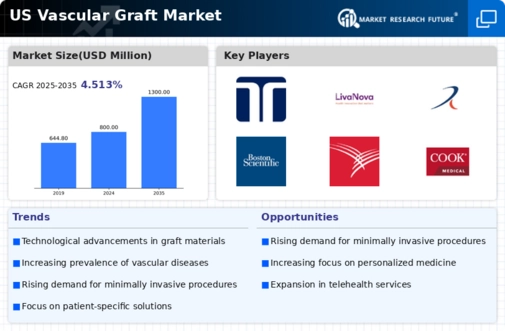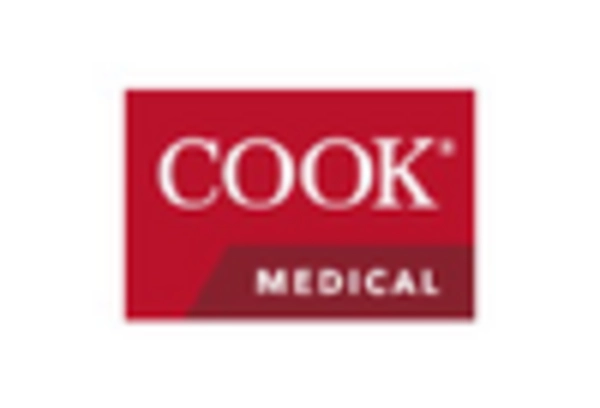Increasing Aging Population
The vascular graft market is experiencing growth due to the increasing aging population in the United States. As individuals age, the prevalence of vascular diseases tends to rise, leading to a higher demand for vascular grafts. According to recent statistics, approximately 15% of the U.S. population is aged 65 and older, a demographic that is expected to grow significantly in the coming years. This demographic shift is likely to drive the need for surgical interventions, including vascular graft procedures. Consequently, healthcare providers are focusing on developing innovative graft materials and techniques to cater to this growing patient population. The vascular graft market must adapt to these demographic changes to ensure that adequate solutions are available for the aging population, which may include both synthetic and biological graft options.
Rising Healthcare Expenditure
The vascular graft market is benefiting from the rising healthcare expenditure in the United States. Increased spending on healthcare services, which has reached approximately $4 trillion annually, indicates a growing commitment to improving patient outcomes. This financial investment is likely to enhance access to advanced medical technologies, including vascular grafts. As healthcare providers allocate more resources towards innovative treatment options, the vascular graft market is poised for growth. Furthermore, the emphasis on value-based care is encouraging hospitals to invest in high-quality graft materials that can lead to better patient outcomes and reduced long-term costs. This trend suggests a favorable environment for the vascular graft market as healthcare systems prioritize effective and efficient treatment solutions.
Advancements in Surgical Techniques
The vascular graft market is being propelled by advancements in surgical techniques that enhance the efficacy and safety of vascular procedures. Minimally invasive techniques, such as endovascular surgery, have gained traction, allowing for reduced recovery times and lower complication rates. These innovations are likely to increase the number of procedures performed, thereby boosting the demand for vascular grafts. For instance, the adoption of robotic-assisted surgeries has shown promising results in improving precision during graft placements. As these techniques become more widely accepted, the vascular graft market is expected to witness a surge in product demand, as surgeons seek high-quality grafts that complement these advanced methodologies.
Growing Awareness of Vascular Health
The vascular graft market is influenced by the growing awareness of vascular health among the general population. Educational campaigns and initiatives aimed at promoting vascular health are becoming more prevalent, leading to increased screening and early diagnosis of vascular diseases. This heightened awareness is likely to result in more patients seeking treatment options, including vascular grafts. As individuals become more informed about the risks associated with untreated vascular conditions, the demand for surgical interventions is expected to rise. The vascular graft market must capitalize on this trend by providing educational resources and innovative products that address the needs of patients seeking vascular health solutions.
Technological Integration in Healthcare
The vascular graft market is being shaped by the integration of technology in healthcare, particularly in the realm of telemedicine and digital health solutions. The rise of telehealth services allows for better patient monitoring and follow-up care, which can lead to improved outcomes for those undergoing vascular graft procedures. As healthcare providers increasingly adopt these technologies, the vascular graft market is likely to see a shift in how patients are managed pre- and post-surgery. This integration may also facilitate more personalized treatment plans, enhancing the overall effectiveness of vascular grafts. The potential for technology to streamline processes and improve patient engagement suggests a promising future for the vascular graft market.

















Leave a Comment